One of the first new releases of 2010 is the Liopleurodon from Safari’s rapidly growing and excellent quality Wild Safari line. This is Safari’s first replica of the infamous Jurassic sea monster, originally made famous for its appearance in Walking with Dinosaurs over a decade ago. Despite the many years that have passed, companies continue to use the WWD depiction as a standard template for their figures (see previous reviews of the WWD, Procon and Chap Mei Liopleurodon figures). So, let’s see if the 2010 Wild Safari Liopleurodon breaks the mold.

Starting with the head, the long narrow jaws show some excellent details. The dentition is based on the most recent reconstructions of the skull of Liopleurodon. Older reconstructions show the teeth splayed out in a ‘rosette’, this is based on the condition seen in preserved pliosaur fossils. However, this is a preservational artifact that results from squashing and compression of the fossils; in life the teeth were implanted more vertically, as captured in the Safari figure. The size of the teeth differs along the jaws, large dangerous-looking fangs are positioned towards the tip. These are separated by gaps in the upper and lower jaws that correspond to other teeth, again this is based on the fossil material. One can easily imagine the tight interlocking teeth when the jaws are closed. As in living reptiles, the jaws and mandibular symphysis (where the left and right parts of the jaw meet) are visible from below. The mandibular symphysis is slightly expanded and the snout is expanded in places too, just as it is in the fossil material.
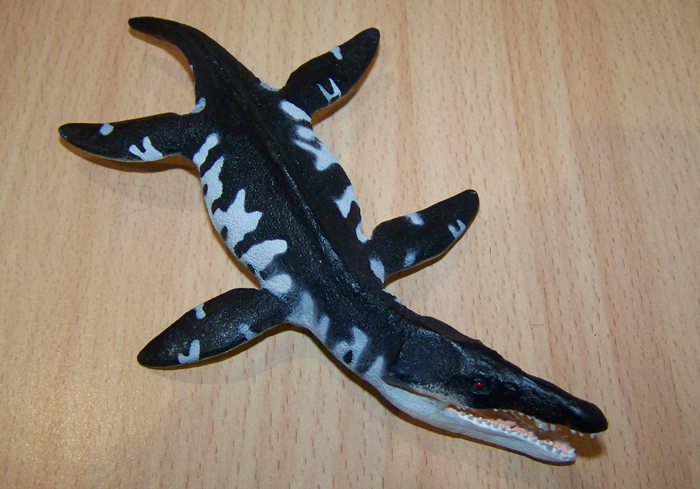
The beady red eyes with black pupils are oriented up and outwards as they were in life, ready to spot the next unfortunate meal. The external nares (nostrils) are situated close to the eyes and on the palate, inside the mouth, even the internal nares are visible. There is also a fleshy tongue. The two large temporal fenestrae are visible at the back of the skull separated by a midline crest, these housed the bone-crushing jaw muscles and may have been even more bulky in life.

Pliosaur skeletons were built to minimize the flexibility of the main body: the Safari Liopleurodon reflects nicely, it appears appropriately strong and sturdy. The muscular regions that covering the large plate-like girdles are visible below. These are particularly obvious in the pelvic region, which was probably a little smoother in life. The neck and tail are curved which adds dynamicity to the posture. There is cloacal opening behind the pubis bone, an anatomical feature often overlooked (or perhaps puposefully omitted?) in many dinosaur figures. The tail is quite short and the head is quite large compared with other Liopleurodon figures.
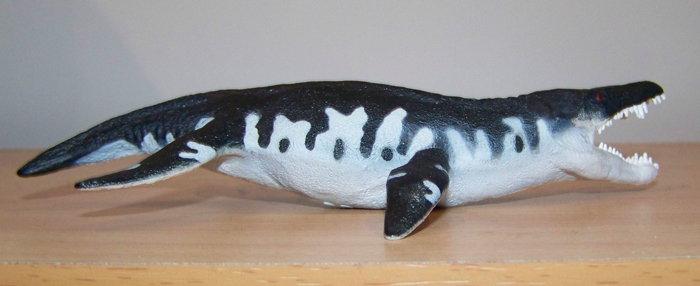
The limbs are all positioned in a relatively passive position. Where they meet the body they are deep to accommodate the strong swimming muscles used to propel it through the water. Other figures often make this region far to thin. The rear flippers are slightly larger than the front ones. This is accurate and typical of most pliosaurs. In contrast, the front flippers are usually largest in the long necked plesiosaurs and elasmosaurids..
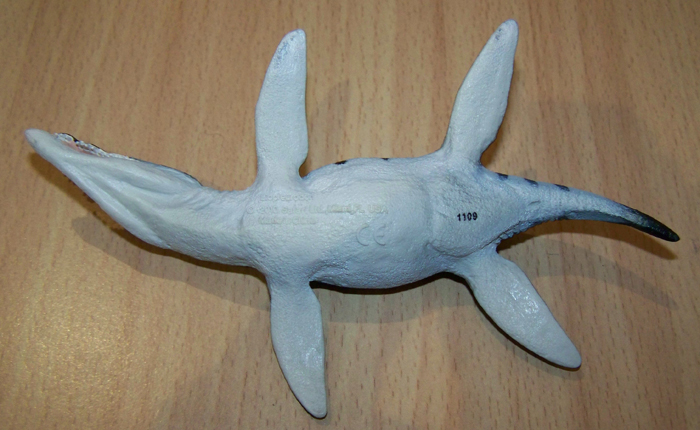
With regard to coloration, Safari have jumped onto the Walking With Dinosaurs bandwagon. Although it would be nice to see a more original colour scheme, one cannot complain too much as the striking pattern of deep blue and white works extremely well, even if it is not unique. The underside is completely white so the animal is nicely countershaded. The texture of plesiosaur skin is unknown; the surface of the Wild Safari Liopleurodon is moderately stippled giving the impression of small scales.
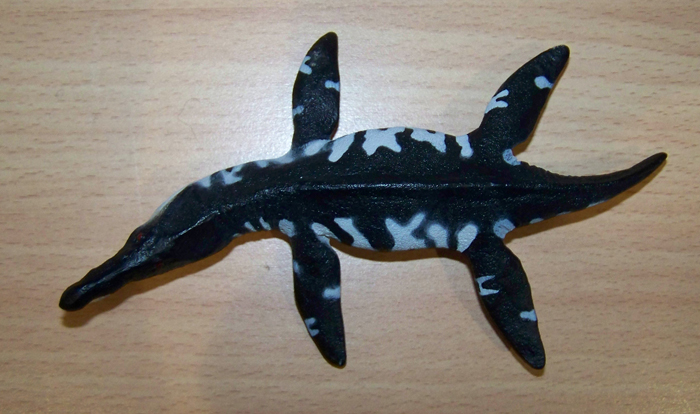
At only 16 cm long this is a small and affordable piece. It is also such a popular species that I predict it will be one of Safari’s bestsellers. Look out for a future blog post where I will outline the design process for this figure.
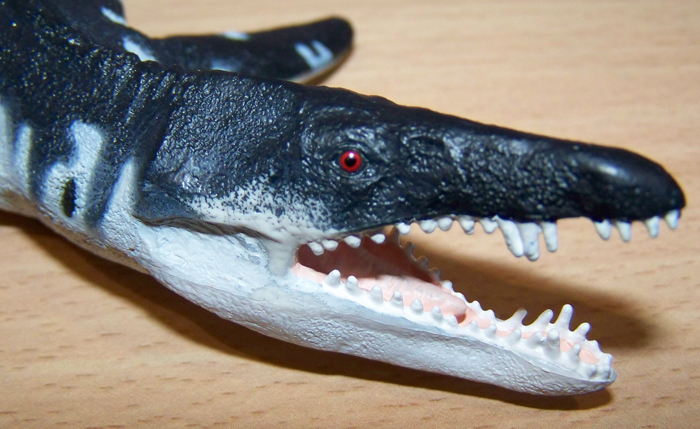
Thanks to DansDinosaurs.com for providing the Dinosaur Toy Blog with a review copy of this figure.
This figure is now available from Dan on Ebay here. It is also available direct from Safari here
Disclaimer: links to Ebay and Amazon on the DinoToyBlog are affiliate links, so we make a small commission if you use them. Thanks for supporting us!




[…] color. You can see and feel bumps on the skin. It is OK to play with but I would recommend the Wild Safari one as it is […]
[…] a slightly rough texture, but it’s not nearly as elaborate as that of the Elasmosaurus or the Liopleurodon. The teeth lining the mouth are fairly sharp, but they’re too small and too numerous. And […]
[…] and I’m delighted how it has come out. While I retained a few minor reservations about the Wild Safari Liopleurodon, I haven’t any issues to raise about the accuracy of this new one. We don’t know that […]
I really like this figure. The maximum size for an average adult Liopleurodon is believed to be 7 metres. I measured my WS Liopleurodon, which I recently acquired, and it’s exactly 1:40 scale!
I really don’t like how Safari is printing dates on their figures. I removed the date on my Liopleurodon and Carnegie Cryolophosaurus using a paint remover.
[…] Liopleurodon by Safari Ltd […]
Es un animal muy bien como casi todos los actuales de la empresa de Safari y Carnegie, pero me parece un plagio del Liopleurodon de Collecta, aunque mejor hecho y la famosa reproducción basada en “Caminando con los dinosaurios” que sólo se comercializó (por desgracia) en Gran Bretaña, y del que tengo todos sus modelos, menos este y el Ornithocheirus. Podrían haber sido un poco más vanguardistas en la pintura del animal.
[…] Liopleurodon by Safari Ltd […]
Wow! I really love this replica. And I don’t even like pliosaurs that much…
Looks great, but will all of them have “1109” written in black between the back flippers?
If liopleurodon The sue figures have the feature too.
Nice figure! I have an ELC Triceratops (apparently the same as the Safari ‘Great Dinosaurs’ one) that has a cloacal opening…
One of Safari’s best works but …
Is not it too small?
Other Safari’s colleagues of Jurassic measured virtually the same (Allosaurus, Stegosaurus …).
Liopleurodon should be BIGGER.
Wild Safari figures are not to scale.